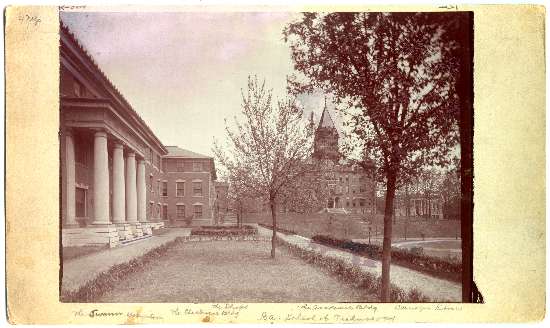 |
GTVA-510-A
Location:
T171 .G42 G49x GTVA-510-A
Title: Date:
[Janie Austell Swann Dormitory and other buildings]
Unknown
Content:
Mat board backing. Backing height and width: 6 5/8 x 11 4/8 in. Spot toning, painting/washes. Sticker on
back of photo. Bottom caption on front backing: The Shops, The Academic Building, Carnegie Library, the
Electrical Building, Georgia School of Technology. Upper left, in pencil: 4 negs. OK-5519. Writing in pen
on back of photo: Please return to H.H. Caldwell, Georgia Tech, Atlanta, Ga.
History:
From Images and Memories: Both Swann Dormitory and the Electrical Engineering Building were added to the
campus in 1901. James Swann of New York offered the School $20,000 if it raised an additional $15,000.
The building has served several occupants through the years. George Griffin tells of the time he and C.D.
"Dummy" LeBey found a loose mule on campus, took it to Swann and tied it to the door of Professor A.H.
Armstrong's room. Swann's rooms today are the offices and classrooms for Continuing Education and the
Department of Modern Languages.
From Warren Drury's thesis: Walter T. Downing, noted Atlanta residential architect, was hired to design
both the Electrical Engineering Building and Swann Dormitory in January of 1901.
Each building, composed in Neo-Classical Revival style, has the three story mass divided into a principle
block of two stories, a string course, and an attic story. The plain brick walls and an uncomplicated roof
line are in keeping with this style as the flat arch lintels and the use of Greek details. The entrance
of each building has been designed as the dominant feature. The Swann Dormitory has a large two story Greek
doric portico over its entrance and the electrical Building has its entrance enframed by a string of Greek
acroteria on the cornice line. The Georgia School of Technology Announcement for 1898-99 discusses the
regulations for conduct, primarily relating to dormitory residence, noting, "The students of the school
have a record for good conduct, unsurpassed by any corps in the country. They are required to obey but few
regulations, the authorities bearing in mind the devlopment and best interests of the student body. Every
man is expected to conduct himself as a gentleman. When he fails in this, and convinces the authorities
that he has not come to work, his parents are requested to withdraw him." Regulations required that
students not leave school property without permission and provided instructions for requesting leaves of
absence from the Professor in charge. The Announcement noted" "no leave of absence will be granted for
theaters, or during the week for religious exercises, without written requests from students' parents."
Dorm life was regulated by the clock in the Academic Building and by a bell system, with the bell for
rising at 6:30 a.m. daily, except on Sunday. The bell for the call to quarters was rung thirty minutes
after supper, at which time students must retire to their rooms to study. Five minutes after call to
quarters, an inspection of each room would be held. After this inspection, visiting between rooms was not
t iring was rung at 10:15
found with playing cards in their possession. Students found with intoxicating liquor or fire arms would
their charge.